Native Son – January, 2011
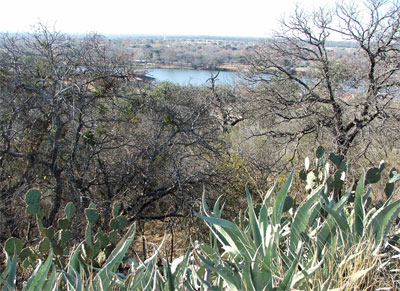
Century plants and prickly pear cactus thrive on a rocky hillside overlooking Lake Marble Falls. All photos by Steven Chamblee.
Road Trip to Wimberley
There’s nothing quite like the special thrill that comes with pond-cleaning season at Chandor Gardens. Gook squishes and slurps underfoot, while that exquisite fragrance, Parfum de Septic, fills your lungs and permeates your skin. Every few minutes the shovel snags on the bottom, sending a delicate spray of fish poo slime arcing gracefully up into the air and across your face. If God’s grace is with you, your mouth will be closed at this particular moment. If not, the neighbors will be exposed to the most colorful “meaning of life” monologue produced since Lenny Bruce headlined in Atlantic City. Two hours later, you drag yourself out of the pit — hands and feet frozen, torso sweaty, back screaming bloody murder, and your entire body covered with a camouflage pattern of viscous black paste and pale green slime. You try to comfort your mind with the knowledge that all of this is organic, and legions of pioneers crossed the plains with nary a roll of toilet paper, disposable diaper, or cold Dr. Pepper in sight. It could always be worse.
Sixteen hours later, I pull over at that little rest stop atop the hill overlooking Marble Falls. I notice a nice group of century plant (Agave americana) clinging to the steep grade, so I go over to check it out. Assessing the situation, I note that if I walk uphill of the agave colony, I’ll likely slide on loose gravel right down onto hundreds of leaves, each armed with dozens of hooked spines along the margins and a sharp tip tough enough to skewer a buffalo. Downhill, the grade is steep enough to stall a mountain goat. I pause to admire the colony, and surmise that it is perhaps 75 years old, and, judging from the faint ring pattern, started from a single specimen. Century plants live about 20 to 30 years, then send up a magnificent 20-foot flower stalk and promptly die. As part of this floral coup de grace, a 10-foot-wide ring of small, vegetative offshoots forms around the base of the dying “mother plant.” These offshoots, lovingly nicknamed “pups,” live on to repeat the process a few decades later. This repeating ring pattern is recognizable for about three generations before the colony appears to be merely randomly strewn.
I begin to wonder who would have had the foresight and raw nerve to plant the original agave in such a formidable location. Did they envision an extensive colony smothering the hillside, preventing erosion, and creating habitat for the rapidly disappearing horny toads of the future? Did they need to perform a daring act of contrition to repent for some unmentionable sin? Did they plant the mother agave on this American soil as a living memento of old Mexico? Thirty miles down the road, I decide the original plant simply fell off a passing truck, lodged into a crevice, and rooted there. Sometimes serendipity is enough.

Blanco Gardens nursery kitten
Stop in at the local nursery in Blanco to find the typical, aloof plant store cat outside, languidly sunning next to a sago palm. Inside the store, I discover the newest ball of fuzz, full of kitten feistiness. What a handful! The owner snags her for a quick photo, and then she is off like a shot. Funny how two cats can be so different. A strange cooing sound leads me through the greenhouse to the attached coop, full of beautiful dove. I like small nurseries in the middle of winter, quietly resting before the spring mayhem arrives.
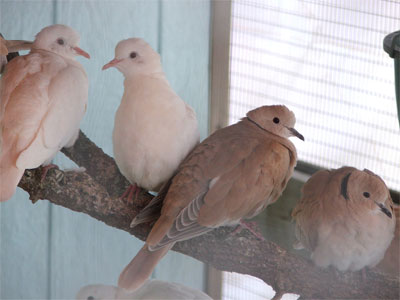
Blanco Gardens greenhouse doves

Hill Country’s ubiquitous
whitetail deer
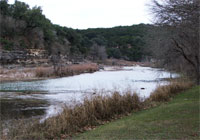
The Blanco River near Wimberley
Half an hour later, I pull into my destination — Wimberley, Texas. I am kind of amazed that I have never set foot here before, as I have circled this area many times. Wimberley simply defines the Texas Hill Country: majestic live oaks, deer, limestone outcrops, deer, relaxed pace, deer, folksy-artsy-craftsy shops, deer, and snaky roads all double-strung up between Cypress Creek and the beautiful Blanco River. Wimberley is the kind of place where you can find bouffant hairdos, cowboy hats, and nose rings all sitting around the same table peaceably … with deer just outside the window. They have a great swimmin’ hole, the only outdoor walk-up movie theatre I ever heard of, and host a massive market day every first Saturday from March through December. They also have a garden club that is nice enough to invite me down for a visit and to speak to their group.
After putting up with my rhetoric for about an hour, the ladies (and two guys!) smother me with praise (which is a lot nicer than the gunk that covered me yesterday) and take me to lunch. Afterward, I tour some lovely gardens, one of which has the nicest tree house I’ve ever seen. A full 30 feet from ground to roof peak, it features stained glass windows and limbs running right through the structure. Another garden has a wonderful labyrinth, constructed of cut stone slabs and pathways sprinkled with colorful pieces of tumbled glass, so that it sparkles in the sunshine. A few feet away, huge cisterns serve not only to collect rainwater for in-house use, but as a canvas for a local artist’s creativity. Rustic grottoes, dry stack cairns, and local sculpture dot the gardens in and around Wimberley, creating a diverse, yet unified feel to the community. I hate to leave.

Left: Wimberley family’s tree house for grandchildren
Right: Private labyrinth in Wimberley
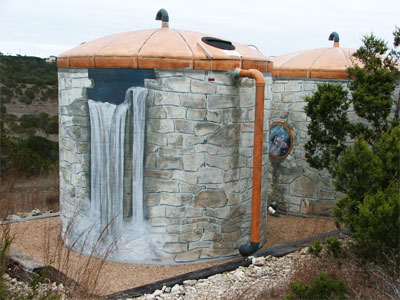
Humorously painted twin cisterns
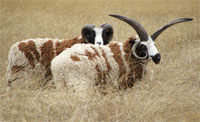
From Old World stock, four-horned sheep

180,000 miles on the dusty truck
A few miles out of town, I wheel the truck around to photograph some magnificent four-horned sheep. I’ve been fascinated by these creatures for decades, but this is the first herd I’ve seen in the flesh/fleece. So I’m standing in the bar ditch, happily snapping away with my camera, trying to catch them in a pose that perfectly portrays those polycerate protuberances … when the largest ram suddenly turns, squares off at me, dips his head a bit, and does some sort of shuddering movement. I almost wet myself. Instinctively, my eyes drop down to quickly check out the fence; three wisps of rusted hope separate me from an animal that can separate me from myself. So I cut a trail for the truck and hope my luck holds out. Once inside, I discover the flock is moving on … and my pants are dry. I set the camera on maximum zoom and peek in the viewfinder. The old ram turns around for one last menacing look and … click! I’ll take it. Before I throw ‘er in first gear, I notice the odometer is sitting squarely on 180K. Now that’s just got to be a good omen.
Soon enough, Wimberley will be in the rear view and I’ll be back in the pond. But for now, I’ve got 200 miles of the best asphalt in Texas ahead of me. It’s a wonderful life.
About the author: Steven Chamblee is the chief horticulturist for Chandor Gardens in Weatherford and a regular contributor to Neil Sperry’s GARDENS magazine and e-gardens newsletter. Steven adds these notes:
At Chandor Gardens, we’ll be performing our winter projects from now until March 1, 2011. You are welcome to visit the garden during this time, but access to some areas may be limited. Come anyway if you can … the squirrels are at their best this time of year! Just take I-20 west to exit 409, hang a right, go 2.1 miles and hang a left on Lee Avenue. Head straight 12 blocks and you’re driving in the gates. Call 817-361-1700 for more information. You can always go to www.chandorgardens.com for a picture tour and more information.
I can always use another road trip! Let me know if you’d like me to come out and speak to your group sometime. I’m low-maintenance, flexible, and you know I like to go just about anywhere. No city too big; no town to small. Just send me an e-mail at schamblee@weatherfordtx.gov and we’ll work something out.

